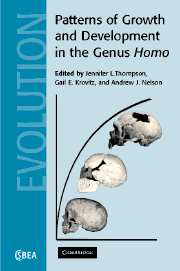Book contents
- Frontmatter
- Contents
- List of contributors
- Acknowledgments
- 1 Introduction
- Part I Setting the stage: What do we know about human growth and development?
- 2 The human pattern of growth and development in paleontological perspective
- 3 Postnatal ontogeny of facial position in Homo sapiens and Pan troglodytes
- 4 Variation in modern human dental development
- 5 Developmental variation in the facial skeleton of anatomically modern Homo sapiens
- 6 Linear growth variation in the archaeological record
- 7 Hominid growth and development: The modern context
- Part II The first steps: From australopithecines to Middle Pleistocene Homo
- Part III The last steps: The approach to modern humans
- Index
- References
6 - Linear growth variation in the archaeological record
Published online by Cambridge University Press: 12 August 2009
- Frontmatter
- Contents
- List of contributors
- Acknowledgments
- 1 Introduction
- Part I Setting the stage: What do we know about human growth and development?
- 2 The human pattern of growth and development in paleontological perspective
- 3 Postnatal ontogeny of facial position in Homo sapiens and Pan troglodytes
- 4 Variation in modern human dental development
- 5 Developmental variation in the facial skeleton of anatomically modern Homo sapiens
- 6 Linear growth variation in the archaeological record
- 7 Hominid growth and development: The modern context
- Part II The first steps: From australopithecines to Middle Pleistocene Homo
- Part III The last steps: The approach to modern humans
- Index
- References
Summary
Introduction
The evaluation of physical development in terms of percentage of mature state attained at a given age measures the tempo of development (Eveleth & Tanner, 1990). For some parameters such as tooth crown and root formation, or fusion of the diaphysis and epiphyses of a long bone, the final adult state is comparable for all individuals and the main difficulty is to define consistent intermediate states of maturation in terms of percentage of final adult state. For measures of skeletal growth the problem lies with the fact that the endpoint, or final adult size, is not always known. In cross-sectional studies, such as those that are conducted on any past population, whether fossil or more recent, the final growth attainment of any immature individual in the sample is both hypothetical and unknown. The mean value for mature individuals in the population under study can be used as an estimate of final growth attainment if this information is available. If other statistical parameters are known for the distribution of size in the adult population concerned, an estimate of error can also be made.
The evaluation of growth in terms of percentage of adult size has several advantages over straightforward measurement of absolute size attainment, particularly in a comparative context. The method adjusts for differences in adult size, and places the emphasis on the rate of progress towards adult size rather than actual size attained at any given age.
- Type
- Chapter
- Information
- Patterns of Growth and Development in the Genus Homo , pp. 144 - 169Publisher: Cambridge University PressPrint publication year: 2003
References
- 23
- Cited by

